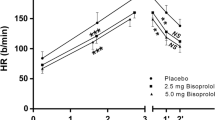Summary
When unacclimatized lowlanders exercise at high altitude, blood lactate concentration rises higher than at sea level, but lactate accumulation is attenuated after acclimatization. These responses could result from the effects of acute and chronic hypoxia on β-adrenergic stimulation. In this investigation, the effects of β-adrenergic blockade on blood lactate and other metabolites were studied in lowland residents during 30 min of steady-state exercise at sea level and on days 3, 8, and 20 of residence at 4300 m. Starting 3 days before ascent and through day 15 at high altitude, six men received propranolol (80 mg three times daily) and six received placebo. Plasma lactate accumulation was reduced in propranolol- but not placebo-treated subjects during exercise on day 3 at high altitude compared to sea-level exercise of the same percentage maximal oxygen uptake (\(\dot VO_{2max}\)). Plasma lactate accumulation exercise on day 20 at high altitude was reduced in both placebo- and propranolol-treated subjects compared to exercise of the same percentage \(\dot VO_{2max}\)performed at sea level. The blunted lactate accumulation during exercise on day 20 at high altitude was associated with reduced muscle glycogen utilization. Thus, increased plasma lactate accumulation in unacclimatized low-landers exercising at high altitude appears to be due to increased β-adrenergic stimulation. However, acclimatization-induced changes in muscle glycogen utilization and plasma lactate accumulation are not adaptations to chronically increased β-adrenergic activity.
Similar content being viewed by others
References
Bender PR, Groves BM, McCullough RE, McCullough RG, Huang SY, Hamilton A, Wagner PD, Cymerman A, Reeves JT (1989) Decreased exercise muscle lactate release after high altitude acclimatization. J Appl Physiol 67:1456–1462
Bucolo G, David H (1973) Quantitative determination of serum triglycerides by the use of enzymes. Clin Chem 19:476–482
Chasiotis D, Brandt R, Harris RC, Hultman E (1983) Effects of β-blockade on glycogen metabolism in humans during exercise. Am J Physiol 245:E166-E170
Cunningham WL, Becker EJ, Kreuzer F (1965) Catecholamines in plasma and urine at high altitude. J Appl Physiol 20:607–610
Davis GC, Shoup RE, Kissinger PT (1981) Determination of serum or plasma norepinephrine by reverse phase liquid chromatography. Anal Chem 53:156–159
Diamant B, Karlsson J, Saltin B (1968) Muscle tissue lactate after maximal exercise in man. Acta Physiol Scand 72:383–384
Edwards HT (1936) Lactic acid in rest and work at high altitude. Am J Physiol 116:367–375
Galbo H, Holst JJ, Christensen NJ, Hilsted J (1976) Glucagon and plasma catecholamines during beta-receptor blockade in exercising man. J Appl Physiol 40:855–863
Gregg SG, Mazzeo RS, Budinger TF, Brooks GA (1989) Acute anemia increases lactate production and decreases clearance during exercise. J Appl Physiol 67:756–764
Hermansen L, Saltin B (1967) Blood lactate concentration during exercise at acute altitude. In: Margaria R (ed) Exercise at altitude. Excerpta Medica Foundation, New York, pp 48–53
Irving MH, Britton BJ, Wood WG, Padghorn C, Carruthers M (1974) Effects of β-adrenergic blockade on plasma catecholamines in exercise. Nature 248:531–533
Kaiser P, Tesch PA, Thorsson A, Karlsson J, Kaijser L (1985) Skeletal muscle glycolysis during submaximal exercise following acute β-adrenergic blockade in man. Acta Physiol Scand 123:285–291
Knuttgen HG, Saltin B (1973) Oxygen uptake, muscle high energy phosphates and lactate in exercise under acute hypoxic conditions in man. Acta Physiol Scand 87:368–376
Maher JT, Jones LG, Hartley LH (1974) Effects of high altitude exposure on submaximal capacity of man. J Appl Physiol 37:895–898
Maher JT, Manchanda SC, Cymerman A, Wolfe DL, Hartley LH (1975) Cardiovascular responsiveness to β-adrenergic stimulation and blockade in chronic hypoxia. Am J Physiol 228:477–481
Mazzeo RS, Marshall P (1989) Influence of plasma catecholamines on the lactate threshold during graded exercise. J Appl Physiol 67:1319–1322
Mazzeo RS, Brooks GA, Sutton J, Butterfield G, Wolfel G, Groves B, Reeves JT (1989) Catecholamine response at rest and during exercise at sea level, acute and chronic exposure to high altitude. Med Sci Sports Exerc 21:S60
Mizuno K, Toyasato M, Yabumoto S, Tanimizu I, Hirakawa H (1980) A new enzymatic method for colorimetric determination of free fatty acids. Anal Biochem 108:6–10
Moore LG, Cymerman A, Huang SY, McCullough ER, McCullough RG, Rock PB, Young AJ, Young PM, Bloedow D, Weil JV, Reeves JT (1986) Propranolol does not impair exercise oxygen uptake in normal man at high altitude. J Appl Physiol 61:1935–1941
Passonneau JV, Lauderdale VR (1974) A comparison of three methods of glycogen measurements in tissues. Anal Biochem 60:405–412
Rosell S (1966) Release of free fatty acids from subcutaneous adipose tissue in dogs following sympathetic nerve stimulation. Acta Physiol Scand 67:343–351
Snedecor GW, Cochran WG (1976) Statistical methods. Iowa State University Press, Ames
Sutton JR, Jones NL, Pugh LGCE (1983) Exercise at altitude. Annu Rev Physiol 45:427–437
Voelkel NF, Hegstrand N, Reeves JT, McMurty IF, Molinoff PB (1981) Effects of hypoxia on density of β-adrenergic receptors. J Appl Physiol 50:63–366
Weiner N, Taylor P (1985) Neurohumoral transmission: the autonomic and somatic motor nervous systems. In: Gillman AG, Goodman LS, Rall TW, Murad F (eds) The pharmacological basis of therapeutics. Macmillan, New York, pp 66–99
Wolfel EE, Hiatt WR, Brammell HL, Travis V, Horwitz LD (1990) Plasma catecholamine responses to exercise after training with β-adrenergic blockade. J Appl Physiol 68:586–593
Young AJ, Cymerman A, Feccia RC, Fulco CS, Maher JT (1982a) Influence of chronic altitude exposure on blood lactate accumulation during progressive exercise. Fed Proc 41:1617
Young AJ, Evans WJ, Cymerman A, Pandolf KB, Knapik JJ, Maher JT (1982b) Sparing effect of chronic high-altitude exposure on muscle glycogen utilization. J Appl Physiol 52:857–862
Author information
Authors and Affiliations
Rights and permissions
About this article
Cite this article
Young, A.J., Young, P.M., McCullough, R.E. et al. Effect of beta-adrenergic blockade on plasma lactate concentration during exercise at high altitude. Eur J Appl Physiol 63, 315–322 (1991). https://doi.org/10.1007/BF00364456
Accepted:
Issue Date:
DOI: https://doi.org/10.1007/BF00364456




